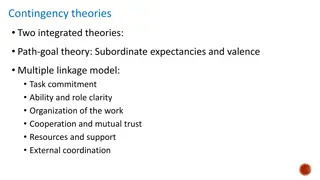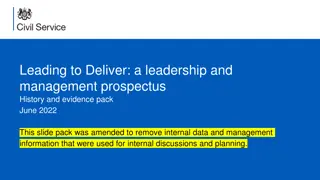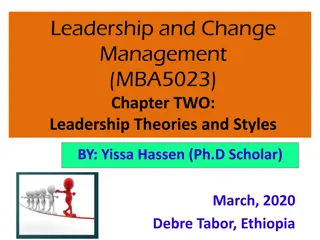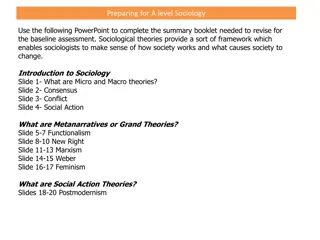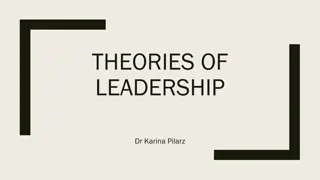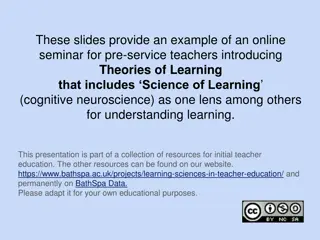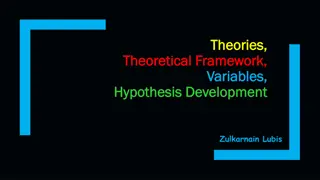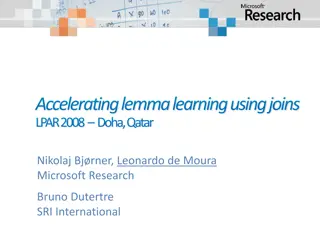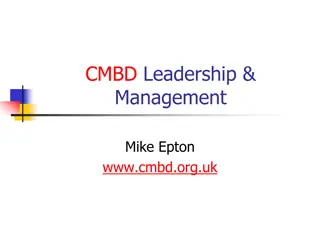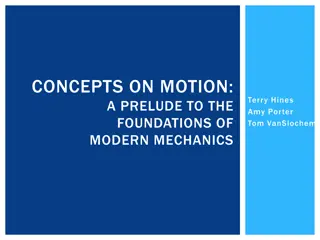Evolution of Leadership Theories: A Historical Overview
Leadership has evolved over the decades, from emphasizing control and domination in the early 20th century to a focus on influence and shared goals in recent years. The definition of leadership has shifted from individual traits to group dynamics and organizational effectiveness, highlighting the complex and multifaceted nature of this highly valued commodity.
Download Presentation

Please find below an Image/Link to download the presentation.
The content on the website is provided AS IS for your information and personal use only. It may not be sold, licensed, or shared on other websites without obtaining consent from the author.If you encounter any issues during the download, it is possible that the publisher has removed the file from their server.
You are allowed to download the files provided on this website for personal or commercial use, subject to the condition that they are used lawfully. All files are the property of their respective owners.
The content on the website is provided AS IS for your information and personal use only. It may not be sold, licensed, or shared on other websites without obtaining consent from the author.
E N D
Presentation Transcript
LEADERSHIP AND ITS THEORIES By Dato; Dr Anuar Md Nor, Class note for Managing Strategic Transformation of Organizations at the Azman Hashim International Business School, Universiti Teknologi Malaysia
Leadership Leadership is a highly sought-after and highly valued commodity. Leadership is a complex process having multiple dimensions. There are almost as many different definitions of leadership as there are people who have tried to define it.
The evolution of leadership definition 1920-1929 Definition of leadership appearing in the first three decades of the 20thcentury emphasized control and centralization of power with a common theme of domination. For example, in 1927, leadership was defined as the ability to impress the will of the leader on those led and induce obedience, respect, loyalty and cooperation (Moore, 1927). 1930 s Traits became the focus of defining leadership, with an emerging view of leadership as influence rather than domination Leadership is identified as the interaction of an individual s specific personality with those of a group, noting that while the attitudes and activities of the many are changed by the one, the many may also influence a leader.
1940s The group approach came into the forefront with leadership being defined as the behavior of an individual while involved in directing group activities (Hemphill, 1949). At the same time, leadership by persuasion is distinguished from drivership or leadership by coercion (Copeland, 1942. 1950s Three themes dominated leadership definitions during this decade: Continuance of group theory, which framed leadership as what leaders do in groups.
Leadership as a relationship that develops shared goals, which define leadership based on the behavior of the leaders. Effectiveness, in which leadership is defined by the ability to influence overall group effectiveness. 1960s The period saw harmony among leadership scholars. The prevailing definition of leadership as behavior that influences people toward shared goals was underscored by Seeman (1960), who described leadership as acts by persons which influence other persons in a shared direction .
1970s The group focus gave way to the organizational approach, where leadership became viewed as initiating and maintaining groups or organizations to accomplish group or organizational goals (Rost, 1991). Burns s definition, however, is the most important concept of leadership to emerge: Leadership is the reciprocal process of mobilizing by persons with certain motives and values, various economic, political and other resources, in a context of competition and conflict, in order to realize goals independently or mutually held by both leaders and followers .
1980s This period exploded with scholarly and popular works on the nature of leadership. As a result, the number of definitions of headship expanded with several preserving themes: Do as the leader wishes: Leadership definitions still predominantly deliver the message that leadership is getting followers to do what the leader wants done. Influence: Probably the most often used word in leadership definition of the 1980s, influence is examined from every angle. In an effort to distinguish leadership from management, however, scholars insist leadership in noncoercive influence.
Traits spurred by popular books: In Search of Excellence (Peters and Waterman, 1982), the leadership-as excellence movement brought leadership traits back to the spotlight. As a result, many people s understanding of leadership is based on a trait orientation. Burns s (1978) is credited for initiating a movement defining leadership as a transformational process, stating that leadership occurs when one or more persons engage with others in such a way that leaders and followers raise one another to higher level of motivation and morality . Into 21stcentury After decades of dissonance, scholars agree one thing: They can't come up with a common definition of leadership (Northouse, 2013). -
Ways of conceptualizing leadership In the past 70 years, as many as 65 different classification systems have developed to define the dimension of leadership (Fleishman and others, 1991). Bass (1990) suggested that some definitions view leadership as the focus of group process. From this perspective, the leaders is at the center of group change and activity and embodied the will of the group. Another set of definitions conceptualizes leadership from a personality perspective, which suggests that leadership is a combination of special traits or characteristics that some individuals possess. These traits enable these individuals to induce others to accomplish tasks.
Other approaches to leadership define it as act of behavior- the things leaders do to bring about change in a group. In addition, some define leadership in terms of the power relationship that exists between leaders and followers. From this viewpoint, leaders have power that they would yield to effect in others. Others view leadership as transformational process that moves followers to accomplish more than is usually expected of them. Finally, some scholars address leadership from a skills perspective,. This viewpoint stresses the capabilities (knowledge and skills) to make effective leadership possible.
Definition and components Despite the multitude of ways in which leadership has been conceptualized, the following can be identified as central to the phenomenon: a. Leadership is a process, b. Leadership involves influence, c. Leadership occurs in groups, and d. Leadership involves common goals. Thus, leadership is a process whereby an individual influences group of individuals to achieve a common goal (Northouse, 2013)
Defining leadership as a process means that it is not a trait or characteristic that resides in a leader, but rather a transactional event that occurs between the leader and the followers. Process implies that a leader affects and is affected by followers. It emphasizes that leadership is not a linear, one-way event, but rather as interactive event. When leadership is defined in this manner, it becomes available to everyone. It is not restricted to the formally designated leader in a group..
Leadership involves influence It is concerned with how the leader affects followers. Influence is the sine qua non (essential condition) of leadership. Without influence, leadership does not exist.
Leadership occurs in groups Groups are the context in which leadership takes place. Leadership involves one individual influencing a group of individuals who have a common purpose. Others (a group) are required for leadership to occur.
Leadership involves common goals Leadership involves attention to common goals. Leaders direct their energies toward individuals who are trying to achieve something together. By common, we mean that the leaders and followers have a mutual purpose.
The people who are engaged in leadership is called leaders, and those toward whom leadership is directed is called followers. Leaders need followers and followers need leaders (Burns, 1978) Although leaders and followers are closely linked, it is the leader who often initiates the relationship, creates the communication linkage and carries the burden for maintaining the relationship.
Traits versus process leadership
We have all heard the statements as he is born to be a leader, or she is a natural leader. These statements are commonly expressed by people who take a trait perspective toward leadership. The trait perspective suggests that certain individuals have special innate or inborn characteristics or qualities that make them leader, and these qualities that differentiate them from non-leaders. Some of the qualities used to identify leaders include: -physical factors, -personality features and -other characteristics (e.g., intelligence and fluency).
The trait viewpoint conceptualizes leadership as a property or set of properties possessed in varying degrees by different people (Jago, 1982). This suggests that it resides in selected people and restricts leadership to those who are believed to have special, usually inborn talents.
Process viewpoint The process viewpoint suggests that leadership is a phenomenon that resides in the context of the interactions between the leader and followers and makes leadership available to everyone. As a process, leadership can be observed in leader behavior (Jago, 1982), and can be learned.
Concept of power The concept of power is related to leadership because it is part of the influence process. Power is that capacity or potential to influence. People have power when they have the ability of affect others belief attitude, and courses of actions.
Five bases of power Referent power Based on followers identification and liking for the leader. Expert power Based on followers perception of the leader s competence. Legitimate power Associated with having status or formal job authority. Reward power Derived from having the capacity to provide rewards to others. Coercive power Derived from having the capacity to penalize or punish others. Source: French and Raven, 1962
In organizations, there are two major kinds of power: (1) Position power, and (2) Personal power Position power is the power a person derives from a particular office or rank in a formal organizational system. It is the influence capacity a leader derives from having higher status than the followers. Personal power is the influence capacity a leader derives from being seen by followers as likeable and knowledgeable. When leaders act in ways that are important to followers, it gives leaders power.
Types and bases of power Position power -Legitimate, -Reward, -Coercive Personal power -Referent, -Expert
Leadership and coercion Coercion power is one of the specific kinds of power available to leaders. Coercion involves the use of force to effect change. To coerce means to influence others to do something against their will and may include manipulating penalties and rewards in their work environment.
Leadership and Management
Leadership is different from management Management Produces order and consistency Leadership Produces change and movement Planning and budgeting -Establish agenda -Set timetables -Allocate resources Establishing direction -Create a vision -Clarify big picture -Set strategies Organizing and staffing -Provide structure -Make job placements -Establish rules and procedure Aligning people -Communicate goals -Sek commitment -Build teams and coalitions Controlling and problem solving -Develop incentives -Generate creative solutions -Take corrective action Motivating and inspiring -Inspire and energize -Empower subordinates -Satisfy unmet needs Kotter (1990)
Both management and leadership is essential if an organization is to prosper. To be effective, organizations need to nourish both competent managers and skilled leadership. Although there are clear differences between management and leadership, the two constructs overlap. When managers are involved in influencing a group to meet its goals, they are involved in leadership. When leaders are involved in planning, organizing, staffing and controlling, they are involved in management. Both processes involve influencing a group of individuals toward goal attainment.
Leadership Theories
There are several leadership theories 1. Trait approach 2. Skills approach 3. Style approach 4. Situational approach 5. Contingency theory 6. Path goal theory, 7. Leader-member exchange theory 8. Transformational leadership 9. Authentic leadership, and 10. Psychodynamic approach
(1) Trait Approach
The trait approach was one of the first systematic attempts to study leadership. Leadership traits were studied to determine what made certain people great leaders. The theories that were developed were called great man theories because they focused on identifying the innate qualities and characteristics possessed by great social, political and military leaders. It was believed that people were born with these traits, and that only the great people possessed them. Research concentrated on determining the specific traits that clearly differentiated leaders from followers (Bass, 1990). In the mid-20th century, the trait approach was challenged by scholars that questioned the universality of leadership traits.
It was suggested that no consistent set of traits differentiated leaders from non-leaders. An individual with leadership traits who was a leader in one situation might not be a leader in another situation. Rather than being a quality that individuals possess, leadership was conceptualized being people in social situation.
Studies of leadership traits and characteristics Stogdill (1948) Stogdill (1974) Kirkpatrick and Locke (1991) Intelligence Alertness Insight Responsibility Initiative Persistence Self-confidence Sociability Achievement Persistence Insight Initiative Self-confidence Responsibility Tolerance Cooperativeness Influence Sociability Drive Motivation Integrity Confidence Cognitive ability Task knowledge
Common leadership traits Intelligence, Self-confidence, Determination, Integrity, and Sociability.
Advantages and criticisms of trait approach There are several advantages to viewing leadership from the trait approach. (1) First, it is intuitively appealing because it fits clearly into popular idea that leaders are special people who are out front leading the way in society. (2) By focusing exclusively on the leader, the traits approach provides an in-depth understanding of the leader component in the leadership process.
On the negative side, the trait approach failed to provide a definitive list of leadership traits. In addition, the trait approach has resulted in subjective list of the most important leadership traits. It is not particularly useful for training and development for leadership because individual s personal attributes are largely stable and fixed, and their traits are not amenable to change.
(2) Skills Approach
Katz (1955) suggested that effective administration (i.e., leadership) depends on three basic skills: technical, human and conceptual. These skills are quite different from traits or qualities of leader. Skills are what leaders can accomplish , whereas traits are who leaders are (i.e., their innate characteristics).
Technical skills Technical skill is knowledge about and proficiency in a specific type of work or activity. It includes competences in a specialized area, analytical ability, and the ability to use appropriate tools and techniques. Technical skills is most important at lower and middle levels of management and less important in upper management. For leaders at the highest level, technical competences are not as essential. Individuals at the top depend on skilled subordinates to handle technical issues of the physical operations.
Human skills It is knowledge about and ability to work with people. It is quite different from technical skill, which has to do with working with things (Katz, 1955). Human skills are people skill. They are the abilities that help a leader to work effectively with subordinates, peers, and superiors to accomplish organizational goals. In short, human skill is the capacity to get along with others as you go about your work. Human skills are important at all three levels of management. Although managers at lower levels may communicate with a far greater number of employees, human skills are equally important at middle and upper levels.
Conceptual skills Broadly speaking, conceptual skills are the ability to work with ideas and concepts. A leader with conceptual skills is comfortable talking about the ideas that shape an organization and the intricacies involved. Conceptual skills are central to creating a vision and strategic plan for an organization. Conceptual skills are most important at the top management levels. Conceptual skills are also important in middle management; as we move down to lower management levels, conceptual skills become less important.
Management skill necessary at various levels of organization
Mumfords skill-based model (Mumford and others, 2000) The model has five components: (1) Competencies (2) Individual attributes (3) Leadership outcome (4) Career experiences, and (5) Environmental experiences
Competencies include: Problem-solving skills, Social judgment skill, and Knowledge skills
Individual attributes include: General cognitive ability, Crystallized cognitive ability, Motivation, and Personality
Leadership outcomes include: Effective problem-solving, and Performance
Career experiences These have an impact on the characteristics and competencies of leaders. The skills model suggests that the experiences acquired in the course of leaders careers influence their knowledge and skills to solve complex problems.
Environmental influences They represent factors that lie outside the leader s competence, characteristics and experiences. These environmental factors can be internal and external. Internal environment influences affecting leadership performance can include such factors as: -technology, -facilities, -expertise of subordinates, -Communication


